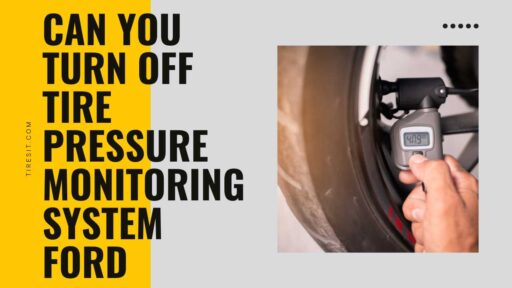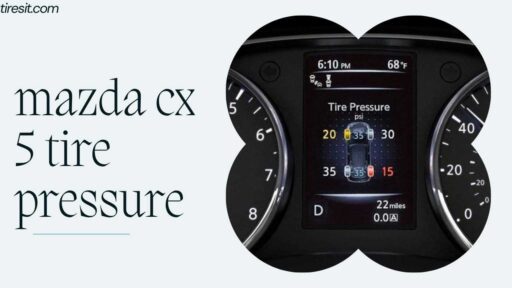Learn the process of deactivating the Can you turn off tire pressure monitoring system Ford car through our comprehensive instructions. Drive with confidence and find out more.
Ever hopped into your Ford and been greeted by that persistent little tire pressure icon, persistently lighting up your dashboard despite the optimal air pressure in your tires? It’s a common experience among vehicle owners, and it can raise feelings of both confusion and frustration. Luckily, there’s a way to tackle this issue head-on: by learning how to turn off the Tire Pressure Monitoring System (TPMS) on your Ford vehicle.
In this article, we’re going to help you do just that! We aim to debunk the mystery revolving around the TPMS in your Ford. Whether your alarm is setting off false positives, or you simply want to better understand your vehicle, we’ve got the answer you’re looking for.
“Not all heroes wear capes – some of them ride around with optimally inflated tires, free from the distraction of that pesky TPMS light!”
So buckle up and get ready: We’re going on a memorable ride to deflate this automotive dilemma once and for all.
Understanding the Can you turn off tire pressure monitoring system Ford
So, it’s clear the Tire Pressure Monitoring System (TPMS) is an invaluable companion in our Ford vehicles. It’s like our car’s silent guardian, keeping an eye out for any potential tire pressure issues. Whenever there’s a struggle in our tires, be it from inaccurate inflation pressure or an issue with the TPMS sensor itself, we often learn of it first from an illuminated light on our dashboard. Incidentally, this first sign is a product of the TPMS sensors located inside each wheel at the drop center area of the tire.
What’s unique about these sensors is how they communicate the tire status to our dashboard display. Emitting a radio frequency when we’re moving at a minimum speed of 20 miles per hour, they keep us informed on the go without inconveniencing our journey.
Now, you might be wondering: do I have the option to turn off this system in my Ford F-150? The simple answer is yes. There’s a method to potentially disable the tire pressure sensor involving the maneuvering of the ignition and brake pedal. By turning the ignition off and on three times while pressing the brake pedal, you can disable the sensor. But should you?
The TPMS, although a minor feature in your Ford, plays a significant role in maintaining your vehicle’s safety and performance. Being alerted of any tire pressure issues allows you to act immediately, hence preventing any potential danger or damage to your vehicle. So, while the answer is yes, the recommendation is a strong no.
Lastly, we must mention that there is indeed an associated cost with the TPMS. However, when measured against the value of safety and maintaining the quality of your Ford’s performance, you’ll likely agree it’s a cost worth bearing.
Why Would You Want to Disable the TPMS on Your Ford?
There are several reasons that might lead you to consider disabling the TPMS on your Ford. However, remember, the TPMS is designed to ensure your safety and alert you to potential tire pressure issues that need your immediate attention. Its function is not just to illuminate a warning light on the dashboard, but to potentially save you from experiencing tire failure while driving.
One of the common reasons some drivers want to disable the TPMS is the sometimes-annoying low tire pressure warning, particularly if they are confident that their tires are correctly inflated. This could indicate inaccurate inflation pressure or reveal deeper issues with the TPMS sensor itself. Another potential reason is the cost of TPMS sensors. Depending on the model of your Ford, these can be quite expensive to replace.
Disabling the TPMS is not recommended because it is a significant safety feature. However, if you are having persistent trouble with the system, you may choose to temporarily disable it until you can get the sensor replaced or repaired.
It’s vital to remember that if you disable your TPMS, it’s even more important to regularly check your tire pressures manually using the tire gauge in your truck. This practice ensures you maintain the right pressure, which is crucial for your safety while driving.
Is It Safe to Turn Off the Tire Pressure Monitoring System?
You may be scratching your head, and rightfully so, at the thought of disabling the Tire Pressure Monitoring System (TPMS) in your Ford. The burning question you might have in your mind is whether it’s safe or not. Let’s discuss this in more detail.
In the big picture of vehicle safety, the TPMS plays a crucial role. It closely and continuously monitors the pressure within each tire via sensors located at the drop center area of the wheel. These sensors emit a radio frequency when the vehicle is moving at a speed of at least 20 miles per hour. So, when the tire pressure drops critically below the recommended standard, the TPMS signals the driver by illuminating a warning light on the dashboard. This warning system helps prevent serious accidents caused by tire blowouts or poor handling due to improperly inflated tires.
With this in mind, disabling the TPMS in your Ford could indeed place you at a higher risk while driving. You may miss vital signs of underinflation or overinflation, therefore losing the opportunity to correct the issue promptly. Moreover, the absence of this real-time monitoring system can lead to premature tire wear, reduced fuel efficiency, and may even compromise the overall performance of the vehicle. So, is it safe? Not convincingly, by most standards.
You might have heard about methods to disable the TPMS, such as turning the ignition off and on three times while pressing the brake pedal. While it’s technically possible to disable or even remove the system in some Ford models like the F-150, we strongly advise against it for the reasons listed above.
Bottom line: Disabling the TPMS is not typically recommended, as it removes a key safety feature designed to protect you and your vehicle. Before making a decision, make sure to weigh the potential risks against the minor convenience it might provide. It’s always best to promote good tire habits, such as regularly checking your tire pressure with a gauge and maintaining proper tire inflation.
Legal Implications of Disabling the TPMS in Ford Vehicles
Let’s make it clear up front: disabling your vehicle’s Tire Pressure Monitoring System (TPMS) can land you with potential legal consequences if not done per the regulations. TPMS plays a crucial role in maintaining safe driving conditions and is, in many jurisdictions, regarded as a requirement, not just a feature. After all, it’s no secret that TPMS offers critical alerts when your tire pressure is too low or high for safe driving conditions.
If you’re thinking about switching off the TPMS in your Ford vehicle, either by removing the sensor or by using a workaround like the key-turn and pedal-press method, do bear in mind that this is likely to contravene vehicle safety regulations. In fact, in many regions, it’s illegal to knowingly disable such a system. Penalties can include fines, and in some cases, they may even impact the validity of your vehicle’s insurance.
Furthermore, keep in mind that TPMS is not an optional feature that you can casually flip on or off. This system, first introduced in the Ford F-150, was created as a vital element in ensuring the vehicle’s safety and performance on the road. Ever since Ford pioneered its use, other manufacturers have followed suit, making it a standard feature in most modern vehicles.
In essence, before disabling TPMS in your Ford, take a moment to understand the legal landscape. Your local laws or automobile regulations are always a good place to start. The few minutes you invest exploring, this could save you a good deal of trouble down the road.
Precautions Before Disabling Your Ford’s TPMS
Foremost, take note of the tires’ current pressure and condition. Always ensure your tires are adequately inflated and in good shape prior to deactivating the TPMS. Keep a tire gauge handy in your truck for manual checks, since TPMS won’t be there to alert you in case of a tire pressure issue.
Try to understand why the TPMS warning light on your Ford F-150 or other models is illuminated. Sometimes, it may indicate inaccurate inflation pressure that needs correcting or issues with the TPMS sensor itself. Do call in the services of a professional mechanic to look into it before deciding to disable the system.
Repeatedly turning the ignition on and off while pressing the brake pedal might potentially disable the tire pressure sensor. But proceed carefully if you choose this route. The TPMS sensors, located inside each tire at the drop center area of the wheel, emit a radio frequency when the vehicle travels at least 20 miles per hour. Therefore, be cautious of any unintended consequences that this may lead to.
Further, assess the cost implications of disabling and potentially re-enabling the TPMS. The financial burden might outweigh the perceived benefits of disabling the TPMS. Hence, make an informed decision based on safety, regulatory requirements, and cost factors before proceeding.
Indeed, the choice to deactivate the TPMS should not be taken lightly. After all, it was introduced as an advanced safety feature to alert drivers of potentially hazardous under-inflated tires in time to take corrective action.
Precautions Before Disabling Your Ford’s TPMS
Before you proceed with disabling the TPMS on your Ford, there are several things you should consider. Notably, as much as it might seem like a viable solution to recurrent alerts or issues with the system, disabling your TPMS should be your last resort. This is because it plays a significant role in your safety while on the road. Irrespective of the Ford model you drive, whether an assertive Ford F-150 or any other robust model, the TPMS is designed to alert you of tire pressure issues, potentially saving you from dangerous situations on the road.
One important aspect to be aware of is that the low tire pressure warning on your Ford F-150 or other Ford models may be more than an annoyance; it could indicate inaccurate inflation pressure or TPMS sensor issues. Both of these problems can lead to decreased vehicle performance, reduced tire life, or even a hazardous blowout. Properly inflated tires also play a role in fuel efficiency, so ignoring a TPMS warning could lead to higher fuel costs over time.
Understanding that the TPMS sensors are located inside each tire at the drop center area of the wheel is also essential. They emit a radio frequency when the vehicle is traveling at least 20 miles per hour. Disabling the system could mean losing this valuable data transmission and possibly causing irreversible damage to the TPMS sensors.
Lastly, consider consulting with a professional or your vehicle’s manual before attempting to disable your Ford’s TPMS. You never want to risk doing further damage to your vehicle. Another precaution is to regularly check your tire’s pressure using a tire gauge in the truck to ensure they are properly inflated, especially if you’ve disabled the TPMS.
Disabling the TPMS in your Ford, although possible, should be approached cautiously and thoughtfully. Keeping these precautions in mind can help ensure your vehicle remains safe and top-performing, even without the TPMS fully operational.

Credit: www.pexels.com
Frequently Asked Questions About the TPMS in Ford Vehicles
Let’s go over some of the most commonly asked questions about TPMS in Ford vehicles to give you the best understanding and to help you make informed decisions.
Can TPMS sensors be disabled or removed in a Ford F-150?
Yes, the TPMS sensors in a Ford F-150 can technically be disabled or removed. However, doing so can expose your vehicle to potential tire-related issues and violate federal safety standards. Proceed with caution and always consider getting expert advice.
Does the TPMS emit any frequencies?
Indeed, they do. When your vehicle is traveling at least 20 miles per hour, the TPMS sensors emit a radio frequency. This is part of their operational process, which helps relay accurate data about your wheels’ condition to your car’s system.
Where exactly in the tire is the TPMS sensor located?
The TPMS sensors are located within each tire, more specifically in the drop center area of the wheel. From there, they can effectively monitor tire pressure and send accurate information to the vehicle’s onboard computer system.
What does a low tire pressure warning on a Ford F-150 mean?
If you see a low tire pressure warning light on your Ford F-150, it could indicate a couple of things. This could be due to inaccurate inflation pressure, meaning that more or less air should be put into the tires. Alternatively, it may also suggest possible TPMS sensor issues that need to be addressed.
Is there a cost involved with TPMS?
Yes, the implementation of a TPMS involves both parts and labor costs. The price can vary depending on the specific model of your vehicle and whether any existing components need to be replaced or not. Also, the cost may increase if professional installation is required. To be certain, it is advisable to consult with your vehicle’s manufacturer or a professional mechanic.
Can the tire pressure sensor be possibly disabled by manipulating the ignition?
There is a method that suggests turning the ignition off and on three times while pressing the brake pedal to potentially disable the tire pressure sensor. However, this method does not guarantee success, and it’s recommended that you consult your vehicle manual or contact a professional technician before attempting it.
Conclusion of Can you turn off the tire pressure monitoring system Ford
In conclusion, the cost and method for replacing a tire pressure sensor will vary depending on your specific vehicle and whether professional installation is required. While there are potential methods to disable it, it is best to consult with professionals or refer to your vehicle’s manual before attempting any alterations. Keeping your tire pressure sensor functioning properly is important for maintaining safe driving conditions, so it’s always best to seek expert advice if you are unsure about how to proceed.





